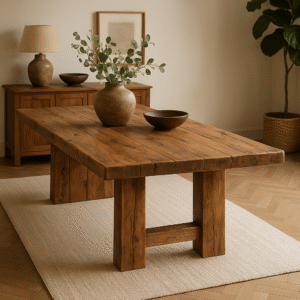Choosing the right wood is the foundation for creating furniture that combines beauty, durability, and practicality. When selecting materials, carpenters and furniture makers need to consider more than just appearance; the quality of the wood will determine how long the piece lasts, how resistant it is to everyday use, and how easy it will be to maintain. A good wood for furniture must bring together multiple characteristics that ensure not only functionality but also long-term value.
Below, we will explore the 10 essential characteristics of good wood for furniture making, highlighting why each one matters and how they directly affect the final product.
1. Natural Durability
Durability refers to how long the wood can last without deteriorating. When a wood type naturally resists moisture, insects, or fungal attacks, it ensures that the furniture will not need frequent repairs. Teak, oak, and walnut are known worldwide for their exceptional natural durability. By choosing a durable wood, the consumer is essentially investing in a piece that will last for generations.
2. Mechanical Strength
Strength is crucial for furniture subjected to weight or impact, such as chairs, dining tables, or wardrobes. Woods like mahogany, jatoba, and rosewood are famous for supporting heavy loads without bending or breaking. A good wood for furniture must be strong enough to withstand daily pressure, ensuring safety and stability over time.
3. Dimensional Stability
Wood is a natural material that responds to environmental changes. Poor-quality woods expand when exposed to humidity and contract when they dry, leading to cracks and distortions. Stable woods like cedar, beech, and maple retain their dimensions, even in changing climates. Dimensional stability guarantees that drawers slide properly, doors align correctly, and tabletops remain flat.
4. Texture and Finishing Qualities
The texture of the wood determines the quality of the finishing. Fine-grained woods allow sanding, polishing, and varnishing to achieve smooth, elegant results. This characteristic is especially important for decorative furniture, where aesthetics are as important as functionality. Ash, cherry, and cumaru are excellent examples of woods that offer a refined finish, making them highly desirable in interior design.
5. Balanced Density
Density influences both weight and usability. While heavy woods like ebony are extremely resistant, they can be difficult to work with and move. On the other hand, very light woods may lack the strength needed for daily use. A good wood for furniture balances these extremes, providing sturdiness without making the furniture impractical. Pine, for instance, offers a lighter alternative that still ensures solid resistance when properly treated.
6. Ease of Workability
Workability refers to how easy it is to cut, sand, glue, and join the wood. Furniture makers prefer woods that do not splinter excessively and that respond well to tools. Eucalyptus and treated pine, though not as prestigious as exotic hardwoods, are widely used because of their excellent workability and versatility. Easy-to-handle woods reduce waste, lower production costs, and speed up the manufacturing process.
7. Aesthetic Appeal
Furniture also plays a decorative role, so visual appearance is essential. The natural grain, veins, and colors of the wood contribute to the uniqueness of each piece. Walnut, for instance, is admired for its rich, dark tone, while zebrawood is chosen for its striking striped pattern. A good wood for furniture should not only be strong and durable but also offer aesthetic qualities that complement different interior styles.
8. Sustainability and Certification
Modern consumers value sustainable choices. Certified wood ensures legal origin and responsible forestry management. Choosing eco-friendly woods helps preserve forests while still guaranteeing high-quality furniture. In addition, many sustainable species, like bamboo and certified eucalyptus, provide excellent performance while aligning with current environmental concerns. Sustainability is no longer just a trend; it is a demand in the furniture market.
9. Resistance to Pests and Decay
Termites, beetles, and fungi can destroy poorly chosen wood in a short time. A good wood for furniture must either be naturally resistant or treated to prevent these threats. Teak, jatoba, and ipe are examples of species with excellent pest resistance. Investing in pest-resistant wood protects not only the furniture itself but also the entire household, avoiding costly repairs.
10. Cost-Effectiveness
Finally, cost-effectiveness is essential. Exotic species such as ebony or rosewood may be beautiful but extremely expensive, limiting their accessibility. Alternatives like tauari, eucalyptus, and rubberwood combine good resistance, beauty, and affordable pricing. A good wood balances cost and quality, making it possible to produce durable furniture that reaches a wider audience.
Conclusion
When evaluating the best materials for manufacturing furniture, it is important to look beyond appearance. The characteristics of good wood for furniture—durability, resistance, stability, beauty, and sustainability—ensure that each piece is more than just an object; it becomes a long-lasting investment.
By choosing the right wood, both the craftsman and the consumer benefit: the craftsman works with a reliable material, and the consumer enjoys furniture that remains strong and beautiful for years. Whether it is a rustic dining table, a modern wardrobe, or a classic rocking chair, the choice of wood defines the difference between ordinary furniture and truly remarkable pieces.


